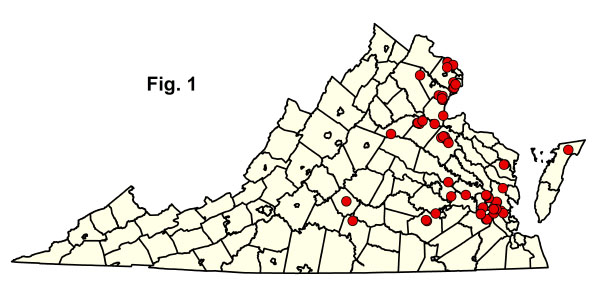
 إدارة الحفاظ على البيئة والترفيه
إدارة الحفاظ على البيئة والترفيه احفظ. احمِ. استمتع.
 إدارة الحفاظ على البيئة والترفيه
إدارة الحفاظ على البيئة والترفيه  جدول المحتويات
جدول المحتوياتمستنقعات السهول الساحلية/مستنقعات بيدمونت النضح الساحلي
تحتوي هذه المجموعة على نباتات حرجية في قيعان مجاري الأنهار الأمامية المضفرة ومنحدرات أخمص القدمين المشبعة بوفرة تصريف المياه الجوفية. تنفصل الوحدات المصنفة في المجموعة على طول تدرج في خصوبة التربة وكيمياء المياه الجوفية، والتي تتراوح بين الحمضية للغاية والفقيرة بالمغذيات إلى الجيرية العالية. على الرغم من التباين الكبير في حالة الركيزة، إلا أن المجتمعات في المجموعة تشترك في موائل متشابهة هيدرولوجياً وطبوغرافياً، بالإضافة إلى العديد من أنواع الأراضي الرطبة التي تتحمل مجموعة واسعة من ظروف التربة.
The more acidic and nutrient-poor seepage swamps, occurring primarily in the Coastal Plain, are characterized by Sphagnum-covered hummocks in a sandy or peaty substrate. The habitats are generally wet and somewhat protected from fire, although adjacent upland forests are generally pyrophytic; there is little doubt that prior to widespread exclusion of wildfires, fire occasionally burned into these habitats during dry periods. Dominant overstory species are red maple (Acer rubrum) and blackgum (Nyssa sylvatica), with tulip-tree (Liriodendron tulipifera) and loblolly pine (Pinus taeda) also locally important. Common small trees and shrubs are sweetbay magnolia (Magnolia virginiana var. virginiana), sweet pepperbush (Clethra alnifolia), highbush blueberries (Vaccinium spp.), swamp azalea (Rhododendron viscosum var. viscosum), smooth winterberry (Ilex laevigata), and southern wild raisin (Viburnum nudum). Compact dodder (Cuscuta compacta) is often abundantly attached to the stems of shrubs in these swamps. Common herbaceous species include cinnamon fern (Osmundastrum cinnamomeum), netted chain fern (Lorinseria areolata), and the sedges Carex lonchocarpa and Carex seorsa. Less widespread herbaceous species that could be considered more or less diagnostic (especially on the Coastal Plain) include skunk cabbage (Symplocarpus foetidus), kidney-leaved grass-of-parnassus (Parnassia asarifolia), Collins's sedge (Carex collinsii), twining bartonia (Bartonia paniculata ssp. paniculata), and the federally listed swamp-pink (Helonias bullata).

Seepage swamps occupying the bottoms of Coastal Plain ravines that have downcut into Tertiary shell deposits or limesands have strongly calcareous soils and groundwater. These very rare, small-patch communities are known from the dissected inner Coastal Plain of Surry, Isle of Wight, York, James City, Gloucester, and Lancaster Counties. Hummock-and-hollow microtopography is prevalent, and exposed shells are common in springs and rills. Green ash (Fraxinus pennsylvanica), red maple (Acer rubrum), and tulip-tree (Liriodendron tulipifera) are common overstory trees in most occurrences, but a subset of ravines on the south side of the James River features the unusual co-dominance of bald cypress (Taxodium distichum) or swamp tupelo (Nyssa biflora). Small trees and shrubs include stiff dogwood (Cornus foemina ), spicebush (Lindera benzoin var. benzoin and var. pubescens), and wax myrtle (Morella cerifera). A number of noteworthy mountain disjuncts have been documented in the herbaceous flora of these communities, including marsh marigold (Caltha palustris var. palustris), rigid sedge (Carex tetanica), bog twayblade (Liparis loeselii; state-rare), swamp lousewort (Pedicularis lanceolata), and American false-hellebore (Veratrum viride). Reaching their northern limits are the southern species Florida adder's-mouth (Malaxis spicata), shadow witch orchid (Ponthieva racemosa), and drooping bulrush (Scirpus lineatus). Other characteristic herbs include lizard's-tail (Saururus cernuus), golden ragwort (Packera aurea), blackfruit clearweed (Pilea fontana), smooth bur-marigold (Bidens laevis), Carolina buttercup (Ranunculus carolinianus), common brome sedge (Carex bromoides spp. bromoides), and common wood reedgrass (Cinna arundinacea). The damp, fertile habitats are particularly susceptible to invasion by the introduced Japanese stiltgrass (Microstegium vimineum). The globally rare Tidewater interstitial amphipod (Stygobromus araeus) appears to be closely associated with groundwater in shell marl deposits.
وقد تم توثيق مستنقعات التسرب ذات الصلة في بيدمونت والسهل الساحلي الشمالي الداخلي في كل من ماريلاند وفيرجينيا، ويبدو أنها تمثل نوعاً يحدث شمالاً حتى جنوب نيو إنجلاند. ويحدث هذا النوع غالباً في مناطق الحواف أو أقواس الثيران المهجورة في السهول الفيضية، حيث يتم تصريف المياه الجوفية من قاعدة منحدر مجاور. وقد أكدت التحاليل المعملية لعينات التربة أن هذه الموائل في سهل بيدمونت/السهل الساحلي الشمالي هي موائل متوسطة في كيمياء التربة بين مستنقعات السهل الساحلي شديدة الحموضة ومستنقعات السهل الساحلي شديدة الجيرية - أي أنها شديدة الحموضة ولكن بمستويات عالية إلى حد ما من الكالسيوم والمغنيسيوم ومستويات تشبع قاعدية كلية. في في فرجينيا، يبدو أن أكثر الأنواع المميزة لهذا النوع هي القيقب الأحمر، والرماد الأخضر، والرماد الأبيض(Fraxinus americana)، وشجرة الخزامى، وشجرة التوليب، وشجرة التوابل، والملفوف الظربان(Symplocarpus foetidus)، وسرخس القرفة (Osmundastrum cinnamomeum)، وعشب الجوهرة البرتقالية(Impatiens capensis)، وعشب القرفة(Pilea pumila).
تعتمد العديد من أسماك الأودونيت غير المألوفة (اليعسوب واليعسوب) على رشح الغابات كموطن للتكاثر. تعتبر مستنقعات السهل الساحلي/بيدمونت الساحلية/بيدمونت مستنقعات التسرب صغيرة الحجم نسبياً ومهددة بأنشطة القندس، والملوثات الزراعية، والاضطرابات الهيدرولوجية، وقطع الأشجار. ويتعرض حاليًا مكون الرماد في هذه المستنقعات لإجهاد كبير بسبب تفشي حشرة حفار الرماد الزمردي الممرض. من شبه المؤكد أن موت الأشجار على نطاق واسع واضطرابات الفجوة المرتبطة بهذه الآفة سيؤدي بالتأكيد إلى تغيرات تركيبية طويلة الأجل وزيادة القابلية للإصابة بالأعشاب الغازية.المراجع: فليمنج (2002أ)، فليمنج (2007)، ماكوي وفليمنج (2000)، روينسكي (1995).
انقر هنا لمزيد من الصور لهذه المجموعة المجتمعية البيئية.
 © دى سى آر دى إن إتشه، غاري ب. فليمنغ
© دى سى آر دى إن إتشه، غاري ب. فليمنغ

 قم بتنزيل جدول بيانات لإحصائيات ملخص التركيب لكل نوع من أنواع المجتمعات المدرجة أدناه.
قم بتنزيل جدول بيانات لإحصائيات ملخص التركيب لكل نوع من أنواع المجتمعات المدرجة أدناه.

